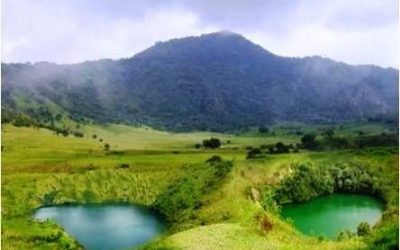
This is the case with mount Bamboutos which is the 3rd highest mountain in West and Central Africa with important ecological functions. It is an important watershed and one of the rich biodiversity hotspots in Cameroon. In less than 40 years, the mountain ecosystem has unfortunately been severely degraded and its rich biodiversity and ecosystems functions are under severe threats of complete extinction. This is due to massive deforestation, intensive and uncontrolled farming in low and high altitude areas. Consequently, the natural vegetation cover has declined, the springs located on the mountainside have dried up, and soil erosion is worsening. The forest reserve created here in 1900 by the Germans has been completely wiped out.
However, the root causes of the environmental threats facing the mountain stem from more specific problems which include: lack of a legal protection status and management plan for Mt Bamboutos leading to unregulated use of natural resources; lack of capacity for effective protection and management of Mt Bamboutos by the regional and Municipal institutions; lack of know-how and incentives for the local communities to sustainably manage natural resources; absence of cross-regional collaboration and coordination among sectorial government Ministries in charge of the Environment, Forestry and wildlife, Agriculture, Regional planning and Livestock. This often leads to a disparity in government action, the design and implementation of sometimes contradictory and antagonistic approaches on the ground, confusion in roles, resistance, ineffective decentralization and inadequate human, material and financial resources.
It is against this backdrop that the Environment and Rural Development Foundation (ERuDeF), through the Mt Bamboutos Initiative (MBI), seeks to restore the degraded Mt Bamboutos ecosystem and its biodiversity while improving on the quality of lives of the local and indigenous communities.
The MBI is a joint initiative of ERuDeF and the International Tree Foundation (ITF), UK in collaboration with the government of Cameroon to support the urgent restoration of the ecosystem and biodiversity of Mt. Bamboutos in western Cameroon. The initiative will cost the sum of 4.5 million US Dollars (27 000 000 000 FCFA).
The project is well-aligned with the Cameroon government’s national priorities and strategies. The restoration of degraded lands is part of the specific objective No. 4 of Cameroon’s forest policy. Cameroon committed to restore over 12 million hectares of deforested and degraded land by 2030 as part of the Bonn Challenge Initiative.
The project which is expected to begin in January 2018 shall run for 15 years with 3 phases of five years each distributed across three regional administrative areas (South West, West and North West) that constitutes the mountain.
Specifically, the project seeks to train and build the capacity of over 30,000 local community members to manage the Mt Bamboutos fragile ecosystems; introduce and establish land use and effective governance systems; ensure food security and economic resilience for over 30000 households while integrating women & gender considerations up stream; securely restore over 25,000 ha of the degraded landscape through the planting of over 15 million trees; secure key biodiversity targets that include the Mt Bamboutos integral ecological reserve (19,000 ha), community forests (10,000 ha) and riparian forests (5000 ha); and to establish a long-term sustainable funding mechanism for Mt Bamboutos both at the community level (through the establishment of the community foundation) and the larger level through the establishment of the Mt Bamboutos conservation trust fund
The following outcomes are expected at project completion:
– The project will enable over 30 000 people in 20 villages in the project zone to become committed to the management of the mountain ecosystem by creating awareness on the environmental threats on the mountain;
– Also, by building the mountain ecosystem management capacities of about 30 000 local peoples and other actors in the project zone, they will be apt and able to manage the mountain ecosystem;
– At project completion, there will be sustainable land use in the project zone thanks to land use zoning and functional land use governance structures put in place by the project;
– It is expected that the degradation phenomena of the Mt. Bamboutos landscape will be stopped by the end of the project through the planting over 15 million trees in degraded areas and farmers’ plots. Soil fertility will increase and the vegetation cover of the mountain ecosystem will increase by 70 % compared to the present situation;
– The project will lead to food security and economic resilience for over 30 000 people in the project zone, bringing about improve nutrition levels, increase employment, increase in household revenue, access to credit and loans, and reduction in real food cost;
– Key biodiversity targets that include an integral ecological reserve (19,000 ha), community forests (10000 ha) and riparian forests (5000 ha) as well as agricultural lands will be secured;
– The ecosystem services and functions of the Mt. Bamboutos ecosystem will be restored and key biodiversity regenerated;
Key beneficiaries of the project shall be the local population (farmers, indigenous Bororo populations and livestock breeders), traditional and municipal authorities, industries as well as the government of Cameroon. The long term sustainability of the project shall be ensured by establishing a financing mechanism at both the community and larger landscape level in the form of a conservation trust fund.
Field operations will be undertaken in collaboration with the project’s local partners being one local NGO selected from each administrative district. ITF and IUCN will be the strategic and technical partners of the project. They shall be responsible for the quality and smooth execution of the project. They shall be consulted on regular bases for technical advice and directives on the project.
With the complexity of the initiative and its financial challenges, ERuDeF and ITF are seeking for cooperation and financial support towards the restoration of this important watershed and biodiversity hot spot in Western Cameroon.



